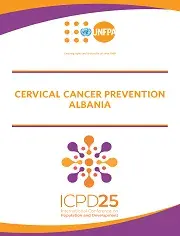Cervical cancer in Albania is a public health problem. It is, with uterus cancer, the second most frequent cancer among women of reproductive age (15-49 years), below only to breast cancer, mainly due to its characteristic increase of risk at middle age. The sexual lifestyle trends among Albanians point to a potential increase of this cancer in the absence of preventative strategies. According to country official data, the average mortality rate of cervical cancer for the period 2013-2017 in Albania is 2.9/100,000 and the incidence rate for the year 2015 (the first year, the national cancer registry has started to operate) is 9.2/100,000
(National NCD report).
The mortality/incidence ratio for cervical cancer in Albania is 32%. Its standardized incidence is lower compared to South East European countries but much higher than Eastern Mediterranean countries.
There is a great deal of potential for prevention, with prevention efforts expected to result in a number of healthy years of life. It is estimated that every year in Albania 2,000-3,000 healthy and productive life years are lost from cervical cancer related disease and death. In a conservative estimate, cervical cancer has costed Albanian society at least six million US dollars yearly, because of productivity loss and health system related costs. Other, family and society related, long term costs, may add to that figure.
Previous to 2010, interventions in the field of cervical cancer prevention were not systematic or sustainable. During the last decade, the efforts started to be better coordinated and integrated to national health policies. A number of health system based analyses, capacity building, awareness activities, policy development and guidelines preparation have been carried out by Ministry of Health (MoH), Institute of Public Health (IPH), University Hospitals (UH) in partnership with United Nations or European Union agencies.
At the end of January 2019, the Albanian government made the important decision to establish the first coordinated national screening program for cervical cancer in the country.
The initial program targets women 40-50 years-old. The goal is to provide all women in this age group high risk HPV screening tests, as part of the routine examinations done at primary health care centers.
To minimize the added workload every screening program brings about, nurses at PHC services are taking more responsibilities from general practitioners. In addition, screening tests based on self sampling, are very practical for women and guarantee minimal workload for health providers.
Although there is an effective vaccine against HPV and its administration among girls of prepuberty age is important, it is demonstrated that vaccination alone is insufficient. To successfully achieve the elimination of the cervical cancer as a public health problem, within the shortest time and with maximum impact, a combination of intensive vaccination, screening and treatment must be applied in population scale.





